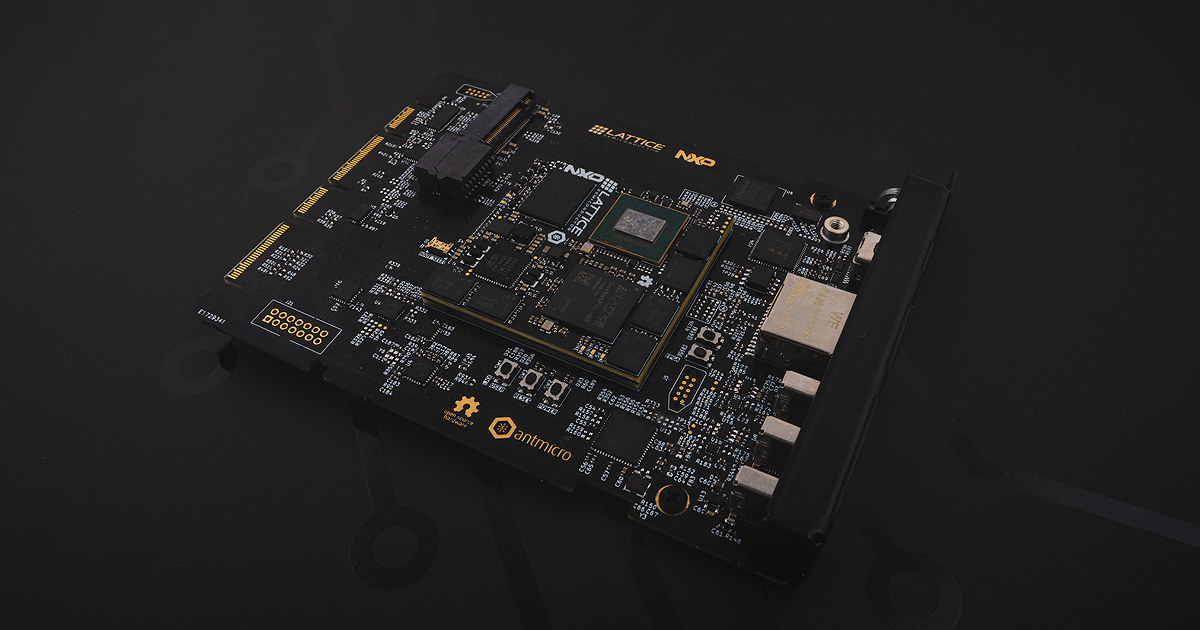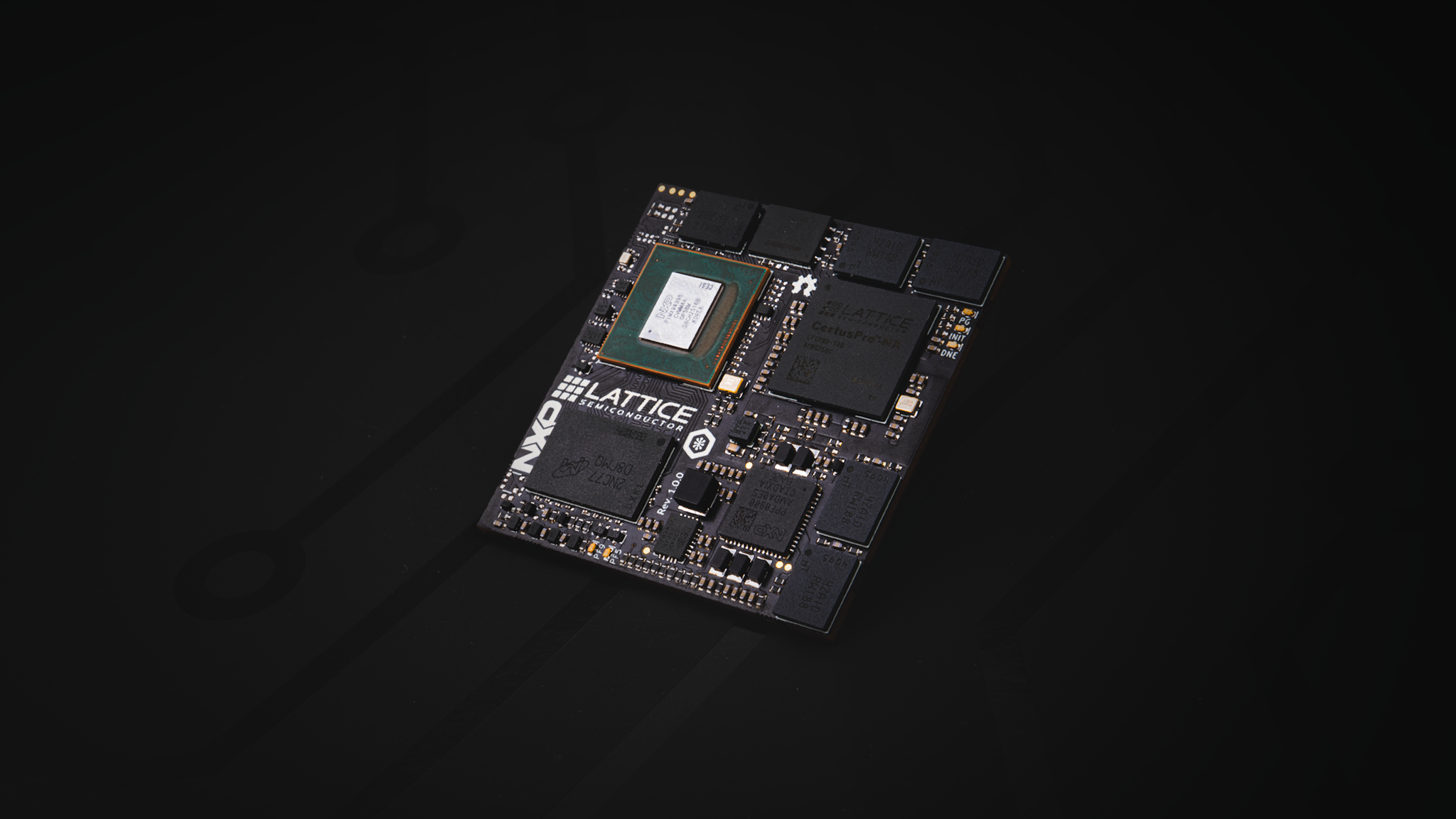Modular, open source DC-SCM 2.1 reference design with Lattice FPGA and NXP SoC
Published:
Topics: Open hardware
Open Compute Project’s Datacenter Secure Control Module (DC-SCM) specification provides an electrical and mechanical standard for Baseboard Management Controller (BMC) cards, moving typical server management, security and control features to a separate, standardized module.
Previously, together with partners including Google and IBM, Antmicro explored taking DC-SCM’s flexibility a step further by developing FPGA-based DC-SCM cards whose hardware could be reprogrammed in the field and adapted to various server setups.
For this year’s OCP Global Summit, we’re combining the best of both worlds and launching a fully open source DC-SCM 2.1 reference platform based on a new open source SoM following the OSM-L standard, including both a powerful multi-core SoC and a state-of-the-art FPGA from our partners NXP Semiconductors and Lattice Semiconductor respectively.

Open source OSM-L SoM with NXP i.MX94 and Lattice FPGA
The reference platform is built around an extremely compact, open source SoM which features NXP’s i.MX943 applications processor with quad Cortex-A55, two Cortex-M33 and two Cortex-M7 cores, as well as a mid-range Lattice FPGA - in the prototype version of the device, a Lattice CertusPro-NX. The release coincides with Lattice’s launch of industry’s first PQC-enabled MachXO5-NX TDQ FPGAs, which will be featured in a soon-to-come revision of the SoM to help further enhance the reliability and future-proof the security of this family of BMC solutions.
The on-board NXP ARM processor handles high-speed interfaces (such as PCie, USB 3.0, GbE), while the Lattice FPGA serves as a sensor aggregation and hardware abstraction layer as well as a Root of Trust.
With this solution, we explore how FPGA-based BMCs can transform board management through hardware virtualization. Historically, BMCs were proprietary ASICs - fixed-function chips requiring custom software and Board Support Packages for every new server platform. This slowed down development, introduced vendor lock-in, and limited adaptability. This reference design redefines how we approach board management - by standardizing both the hardware and software stack, and eliminating the need for custom BSP development across server platforms.
The 45x45mm SoM follows the Open Standard Module OSM-L specification, created and maintained by the SGeT group, which standardizes several compact form factors of pin-compatible Land Grid Array (LGA) solderable modules. With high pin density and low mounting cost (no extra connector needed), these types of modules have seen widespread use in wireless applications, and standardizing the form factor and pinouts makes them a great fit for cross-vendor portability in more general purpose applications. As illustrated by the BMC use case, OSM allows for encapsulating the complexity of CPUs, FPGAs, local storage, power management and clocking into a single reusable block (including in custom, non-DC-SCM compliant BMC variants).
Conforming to a pre-defined OSM-L pinout and form factor means that this SoM can also act as a drop-in upgrade for SoC-only modules for applications beyond the server room including robotics, drones and industrial.
The i.MX943 SoC can run both Linux (including support for Yocto, which makes it easy to integrate e.g. with Antmicro’s OTA framework, RDFM, and functional testing tool, Protoplaster) as well as Zephyr RTOS. In this particular application, the standard open source OpenBMC Linux distribution is used to enable typical BMC functionalities, including a web server and remote UI.

DC-SCM Reference Carrier Board with BMC-oriented features
The SoM is meant to be soldered onto another open hardware PCB, a DC-SCM 2.1 carrier board which break-routes the I/O interfaces provided by the OSM-L module to the on-board interface connectors - the server’s DC-SCM slot on the one hand and the server enclosure on the other.
The carrier board features a USB-C connector combined with an on-board FTDI FT4232 USB-serial converter. This provides 4 debug channels with I2C, UART and JTAG connectivity for the SoM. The default hardware configuration of this interface allows re-flashing and debugging the processing chips (both the NXP SoC and Lattice FPGA) located on the SoM via JTAG and exposing a debug serial console from them. The second USB-C connector is tied to the SoM directly and allows interacting with the processing modules located on the SoM - this sort of interaction in particular can lead to re-flashing the processing modules located on the SoM with a Board Support Package or using the USB port as a general-purpose I/O interface when the SoM is not set into flashing mode. The third USB-C connector passes the USB connection from the HPM (Host Processor Module, i.e. server motherboard) forward. Similarly, the on-board M.2 connector exposes the PCIe interface that is routed to the HPM.
The DC-SCM card also includes a Gigabit Ethernet port with an on-board PHY implemented with Realtek RTL8211FDI-CG.
The video output of the DC-SCM is exposed on a mini DisplayPort connector (as defined by the standard). Since the OSM-L pinout does not include a DisplayPort interface per se, the DC-SCM card includes a simple bridge from ITE which converts LVDS into DisplayPort. In addition to that, the DC-SCM card includes eMMC and SPI flash memories that can be used in combination with the SoM.
The card also includes a slot for a UEFI BIOS Flash memory IC that can be connected directly to the SPI interface connected to the HPM. According to the DC-SCM standard, this SPI interface can then be used for booting the CPU located on the HPM.
Just like the accompanying SoM, the DC-SCM board design has been released as open hardware, so the connections between the core interfaces and functional blocks outlined above are fully customizable. Once combined with an SoM module that features programmable logic, the DC-SCM card becomes a versatile development platform that allows implementing, validating and benchmarking various server management scenarios.
See the demo in System Designer
While both the open source hardware boards are available in Antmicro’s Open Hardware Portal and components library, the way they combine into a complete DC-SCM BMC solution is best explored using the System Designer portal, with a dedicated entry for the OCP demo setup in the overarching BMC reference design project.
The complete scenario with a DC-SCM 2.X-compatible Intel Birch Stream Gen server is described, connecting software and FPGA assets (to be released post-OCP) with the specific processing components they are dedicated for - the CertusPro-NX FPGA and the i.MX94 part on the SoM, and another Lattice FPGA - MachXO3D - on the server. Those assignments can be visualized in a multi-layered system diagram using System Designer’s built in diagramming tool, with the software/FPGA assets bubbling up to the top of the diagram hierarchy.
The System Designer entry also features the upcoming MachXO5-NX TDQ variant of the SoM, as well as the development kits used for development and other components.
See the OCP demo in action, discuss customizations
If you are attending the OCP Global Summit in San Jose this week, make sure to contact us to arrange a dedicated demo of the DC-SCM solution in the Lattice meeting rooms adjacent to the OCP exhibition floor.
Antmicro provides a wide array of engineering services and open source frameworks for both server applications and beyond, and can help you build a solution around the open source OSM-L module or adapt it to your needs - meet us at OCP to discuss those.
We work on many levels of the hardware and software stack, enabling true vertical integration by providing commercial support and integration services; our work in data centers spans from building dedicated hardware clusters and scalable compute cluster software as well as hybrid cloud integrations, RTL, DV and software development for open source Root of Trust projects including Caliptra and OpenTitan, to custom data center security test platforms, such as the Rowhammer tester framework. If you won’t get a chance to meet us in person but would like to learn more about our services or discuss your project, reach out to us at contact@antmicro.com.
